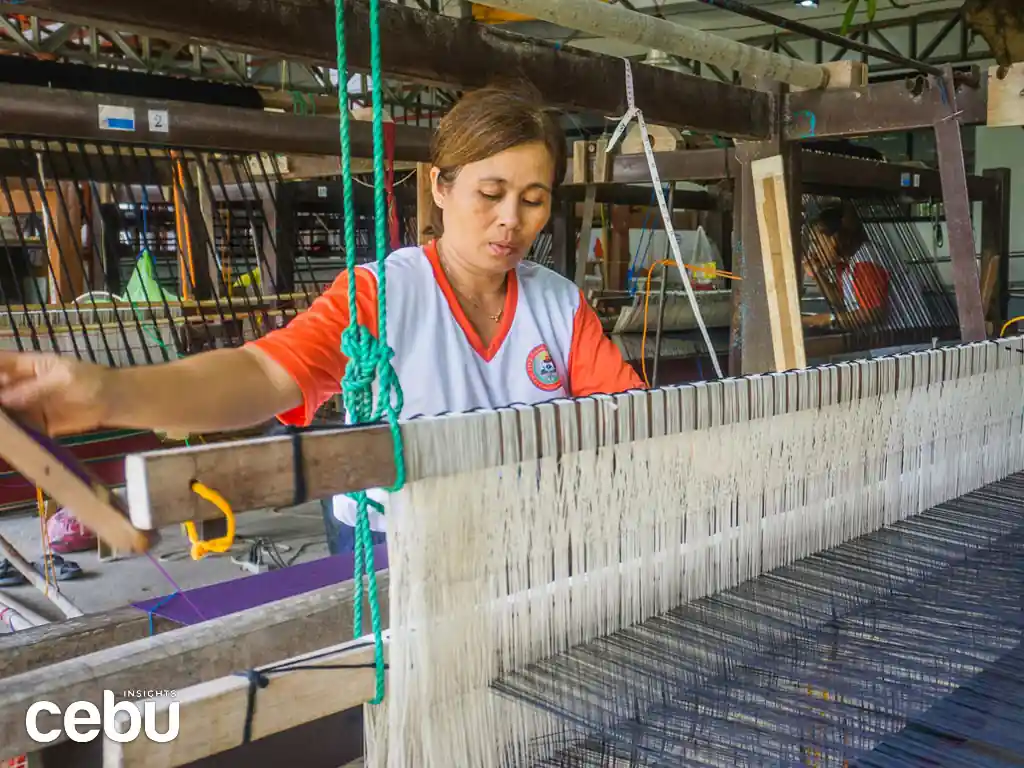Hablon has become an essential part of the southern town of Argao.
Argao has a number of establishments and products that perfectly represent Cebu culture. The local food industry, for instance, brought about iconic snacks and treats like torta and tableya, including the famous alcoholic drink known as tuba.
The beaches and churches in this southern Cebu town have also sparked interest among locals and tourists alike.
Argaoanons have their own centuries-old, albeit lesser-known art form that has thrived as a lucrative business since the pre-colonial era. It’s a cottage industry that was passed on for generations and is still operating today.
Argao’s local handloom weaving industry is called Hablon. It is derived from the Bisaya word habol, which means blanket, or to cover oneself from the cold.
This traditional technique is more practical and conventional compared to other types of weaving, but requires skill and patience that takes years of practice to perfect.
In Argao, one can learn so much about the history of weaving and its importance in Cebu culture.
HISTORICAL SYMBOL OF ARGAO
The history of weaving dates back to when the Spaniards arrived in Cebu in the 1500s. Most of the earliest hablon practitioners were women, weaving blankets and other textile products using a variety of fibers.
Almost all the women in the town of Argao were considered weavers, and since they mostly worked at home, it was easy to pass on the practice to their younger relatives and siblings.
Many weavers (sometimes called Tejedoras) today come from families of weavers, carrying on the tradition into the 21st century.
The intricate handloom weaving of the hablon made it a sought-after product for making clothes. Even today, designers use it as material for a beautiful Filipino dress or barong.
The tedious process of weaving has produced many iconic Cebu products.
HOW IS HABLON MADE?
Weavers use heavy machines made up of wooden boards, poles, and strings that they pull or lift by hand. This process can be rather tedious for the inexperienced.
Before the hablon-making process starts, the weavers organize the strings within the machine to maintain consistency and efficiency when weaving. This process is essential, as one mistake could result in a poorly made product.
Weavers tighten the yarn through a wheel that spins the thread around wooden cylinders. Wooden containers hold the thread to allow weavers to insert them between the strings of the machine.
Bamboo pedals from under the machine determine the order of the colors used in the patterns for the final product. Weavers would sometimes use multiple pedals based on the colors and patterns used.
Making the perfect hablon requires a lot of skill and dedication. Over 900 strands of fibers like polyester, abaca, and cotton are needed to make a 36-inch hablon, the regular length of the finished product.
Despite this, the effort and concentration required have spawned beautiful creations that look simple but expensive. These pieces are recognized as Filipino in design, making them some of the most sought-after Cebu products.
SUDDEN DECLINE AND SLOW RISE
As imported fabrics became more popular, handwoven products became less valuable. More designers and clothing manufacturers would order from outside the country rather than pay a hefty price or travel far to order sheets of hablon.
Argao saw a decline in weavers, with only a few areas continuing their hablon business due to the lesser demand for the product.
Fortunately, Argaoanons have started projects to preserve the hablon as a cultural landmark of the town. One of them is rebranding and improving the community as the “Hinablon sa Cebu.”
The program started as a community extension project by students from the Cebu Technological University – Argao Campus (CTU) in 2013 to provide weavers with a better livelihood through better pay and an improved working environment to save the weaving industry.
Hinablon sa Cebu has helped many weavers by providing training workshops to create better products. It also gives weavers a more stable source of income, as weaving before the project started did not generate as much.
Today, weavers stay at the CTU-Argao Campus, creating various products, from bags, pillowcases, scarves, and dresses, on a daily basis. You can find many of their products at the showroom inside CTU.
They also have embroidery and sewing machines to make even more intricate designs.
Schools and universities have regularly tapped Hinablon sa Cebu to make sashes for graduation. Others order a piece of clothing made in Argao to represent their Argaoanon heritage.
Moreover, the local government has encouraged the use of hablon in many pageants, like the Dalagang Argaoanon in 2016, which featured original pieces designed by local fashionistas in partnership with the weavers.
Hablon products have also been featured in multiple DTI trade fairs in shopping malls like Ayala Center Cebu. These exhibits bring hablon to an even more accessible location where people around the city can see the local product without having to travel far.
World-renowned designer Kenneth Cobonpue and design company HoliCow are industry partners of Hinablon sa Cebu, challenging the weavers to create more accurate weaves for furniture and other items.
The weaving industry in Argao may be understated and lesser-known even among Cebuanos, but it is an essential part of Cebu culture. Hablon carries the Cebuano brand of creativity through mesmerizing works of art in fashion, architecture, and design.
The industry has resurfaced recently as the local government unit, along with other design groups, has turned hablon into one of the premier fashion products in Cebu. It continues to create a look and feel that is recognizably Filipino.

















